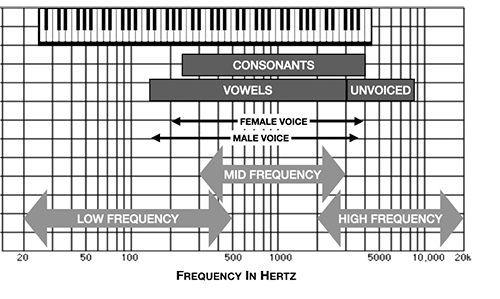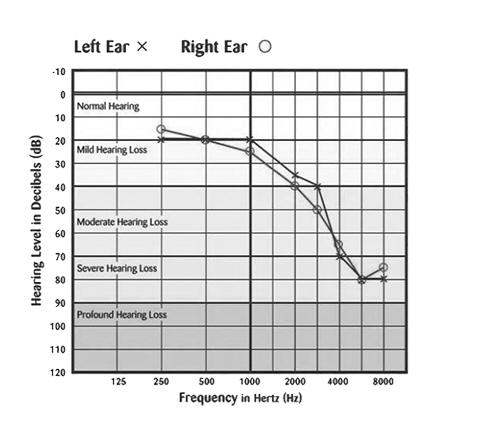
By Rev. Paul Wooley
There are various reasons that some members of a congregation may have difficulty hearing the spoken word. However, the ‘pachyderm in the room’ is that the age distribution of most congregations is heavily weighted toward senior citizens.
Years of noise exposure and the aging process both lead to deficits in hearing for a large proportion of the senior population. Since many sound systems fail in being able to provide sufficiently accurate sound reproduction to service the needs of those affected. This article is an attempt to help to explain the nature of the problem.
I have included what might look like a fairly complicated diagram, but which may help to explain the basic problem of reproducing the spoken word.
Along the top is a small piano keyboard simply for reference. At the bottom of the diagram, the scale is given in Hertz which is the measure of the frequency or pitch of sounds across the range of frequencies detectable by the human ear.
For reference, the sound spectrum is divided into low frequencies, mid-frequencies, and high frequencies. (In a hi-fi loudspeaker system, this would be a woofer, mid-range, and tweeter!)
The diagram also gives the pitch ranges where most of the sound power is contained in average male and female voices.
Speech occurs when air is forced past the vocal cords, causing them to vibrate. The vibrations become a fundamental tone, and the oral and nasal cavities resonate much like an organ pipe and give tonal structure to the sound. The more air forced past the vocal cords, the stronger the sound.
 As we place the tongue and the lips in different positions we form different letters – vowels, voiced and unvoiced consonants. The vowels (a, e, o etc.) are formed from the fundamental tone with most of their power from 250 – 2,000 Hz power and are generally stronger than voiced consonants (b, d, m etc.) in the range 250 – 4,000 Hz. Unvoiced consonants (f, s, t etc.) vary in strength and lie in the frequency range of 2,000 – 8,000 Hz.
As we place the tongue and the lips in different positions we form different letters – vowels, voiced and unvoiced consonants. The vowels (a, e, o etc.) are formed from the fundamental tone with most of their power from 250 – 2,000 Hz power and are generally stronger than voiced consonants (b, d, m etc.) in the range 250 – 4,000 Hz. Unvoiced consonants (f, s, t etc.) vary in strength and lie in the frequency range of 2,000 – 8,000 Hz.
The second diagram included is an audiogram, the type you receive from a hearing test.
 This audiogram is indicative of someone with pronounced hearing loss. However, it is an example of what happens with most people’s hearing loss, in that it is the higher frequencies that suffer the most. In such a case, when listening to speech the low-frequency vowels are heard, but the consonants and unvoiced consonants are generally lost to some degree. This makes all speech sound like the speaker is mumbling!
This audiogram is indicative of someone with pronounced hearing loss. However, it is an example of what happens with most people’s hearing loss, in that it is the higher frequencies that suffer the most. In such a case, when listening to speech the low-frequency vowels are heard, but the consonants and unvoiced consonants are generally lost to some degree. This makes all speech sound like the speaker is mumbling!
Although those with hearing loss will suffer the most, it should be noted that even people without hearing loss will have problems if the higher frequencies are not reproduced fully.
Proper loudspeaker systems for churches, need to have a high-frequency speaker, (called a tweeter) which broadcasts over the seated area. These speakers use a horn section to perform this task and are often selected for a specific installation.
Preachers and readers should not get too close to microphones, since many microphones have what is called a ‘bass proximity effect’. In that case, vowels are accentuated and voiced and unvoiced consonants almost disappear.
Hearing aids are of great assistance to those with hearing loss. The newer digital models can be programmed to specific needs. But all of that technology is not the same as normal hearing.
Additionally, there are those who prefer not to wear hearing aids and those who have not fully realized their hearing loss, and some who simply can’t afford them.
Over the years there have been a number of technologies developed to assist congregants with hearing loss. Some of these have been, headphones wired directly to the sound system, wireless and infrared headphones, and inductive loops to broadcast the sound to the ‘telephone’ or ’T’ coils in hearing aids.
The latest movement is the equipping of churches with a system that makes use of the ‘Bluetooth’ capabilities of the newer digital hearing aids. I will attempt to cover the various available assistance systems in a future article.
Rev. Paul Woolley is a retired priest in Huron. He has 55 years of experience working with audio equipment of every description for varied venues.
RELATED:
Improving church sound systems